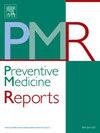Multiple and frequent tobacco product use by sexual minority youth in the United States: Results from the 2023 National Youth Tobacco Survey
IF 2.4
3区 医学
Q2 PUBLIC, ENVIRONMENTAL & OCCUPATIONAL HEALTH
引用次数: 0
Abstract
Objective
Understanding tobacco product use among sexual minority youth is important due to the exposure to nicotine and toxicants, which worsens tobacco-related health disparities. We used recent US national data to characterize tobacco product use by sexual identity.
Methods
Data were drawn from the 2023 National Youth Tobacco Survey (NYTS), a nationally representative survey of US middle and high school students (N = 20,503). Sexual identity categories included “heterosexual”, “gay/lesbian”, “bisexual/pansexual/queer”, “asexual”, “questioning”, “I do not know what this question means”, “something else”, and “decline to answer.” Outcomes were past-30-day (1) multiple tobacco product use (number of products) and (2) frequent tobacco product use (≥20 days). Weighted Poisson regression models examined associations between sexual identity and tobacco use, adjusting for covariates.
Results
In 2023, there was more tobacco product use (adjusted prevalence ratio[aPR] = 2.35, 95 % CI = 1.15, 4.79) and more frequent tobacco product use among gay/lesbian (aPR = 2.89, 95 % CI = 1.42, 5.87) and asexual youths (aPR = 2.92, 95 % CI = 1.41, 6.04) (vs. heterosexual youth) in the past 30 days. Compared to heterosexual youth, gay/lesbian and asexual youth were more likely to report combustible tobacco use, while bisexual, pansexual, queer, and questioning youth were more likely to use non-combustible products, such as e-cigarettes and nicotine pouches.
Conclusions
This study observed more multiple and frequent tobacco product use among US sexual minority youth than heterosexual youth. These disparities by sexual identity emphasize the need for targeted tobacco prevention and cessation programs. Public health interventions should address unique stressors and risk factors contributing to tobacco use among sexual minority youth.
美国性少数群体青少年多次和频繁使用烟草制品:2023 年全国青少年烟草调查的结果
目的了解性少数青少年的烟草制品使用情况很重要,因为他们暴露于尼古丁和有毒物质中,这加剧了与烟草相关的健康差距。我们使用了最近的美国国家数据,以性别身份来描述烟草产品的使用。方法数据来自2023年全国青少年烟草调查(NYTS),这是一项具有全国代表性的美国中学生调查(N = 20,503)。性身份分类包括“异性恋”、“男同性恋/女同性恋”、“双性恋/泛性恋/酷儿”、“无性恋”、“质疑”、“我不知道这个问题是什么意思”、“其他的”和“拒绝回答”。结果为过去30天(1)多种烟草制品使用(产品数量)和(2)频繁烟草制品使用(≥20天)。加权泊松回归模型检验了性别认同和烟草使用之间的关系,调整了协变量。结果2023年,与异性恋青少年相比,男女同性恋青少年(aPR = 2.89, 95% CI = 1.42, 5.87)和无性恋青少年(aPR = 2.92, 95% CI = 1.41, 6.04)在过去30天内使用烟草制品的比例较高(校正患病率[aPR] = 2.35, 95% CI = 1.15, 4.79),使用烟草制品的频率较高。与异性恋青年相比,男同性恋/女同性恋和无性恋青年更有可能报告使用可燃烟草,而双性恋、泛性恋、酷儿和质疑青年更有可能使用非可燃产品,如电子烟和尼古丁袋。结论:本研究发现,美国性少数群体青少年使用烟草产品的次数和频率高于异性恋青少年。这些性别认同差异强调了有针对性的烟草预防和戒烟规划的必要性。公共卫生干预措施应解决导致性少数群体青少年使用烟草的独特压力源和风险因素。
本文章由计算机程序翻译,如有差异,请以英文原文为准。
求助全文
约1分钟内获得全文
求助全文
来源期刊

Preventive Medicine Reports
Medicine-Public Health, Environmental and Occupational Health
CiteScore
3.90
自引率
0.00%
发文量
353
 求助内容:
求助内容: 应助结果提醒方式:
应助结果提醒方式:


